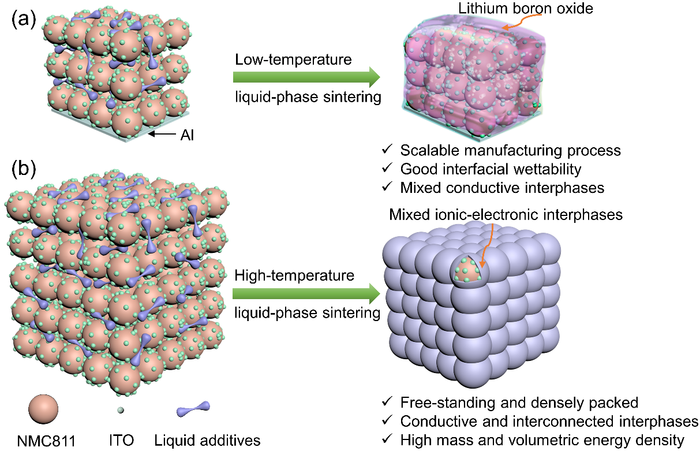Solid-state batteries for electric vehicles, which offer higher energy density and range compared to contemporary lithium-ion batteries, are still out of reach, owing to challenges posed by the cathode composition. This problem could potentially be solved by a new cathode composition and manufacturing technique.
 Researchers designed solid-state composite electrodes based on the liquid-phase sintering technique. Image Credit: Nano Research.
Researchers designed solid-state composite electrodes based on the liquid-phase sintering technique. Image Credit: Nano Research.
The research was published on March 24th, 2022, in the journal Nano Research.
Rechargeable solid-state batteries (that are completely solid and do not contain any liquid components) have long been touted as the next generation of energy storage, particularly for electric vehicles and other climate-related applications. They will be smaller, lighter and more energy dense than existing lithium-ion batteries, with a longer range and faster recharging.
The latter uses a liquid electrolyte as the medium for current to flow between the negative and the positive electrodes (the anode and cathode, respectively). The liquid, on the other hand, makes the battery heavy. It is also flammable, which means that fires are rather common.
A solid electrolyte made of glass, ceramic or a polymer is much safer in a solid-state battery because there are no leaks or splashing around while in transit, and it offers enhanced cyclability, power density and shelf life.
Designing a good cathode capable of a high operating voltage and high area capacity is crucial to making solid-state batteries work. For a given period of time, the latter term implies the amount of energy charge in a battery per unit of area.
In comparison to a given amount of area, the milliampere-hour (mAh) is a commonly used unit to describe this quantity — or the amount of energy charge that will allow 1 amp of current to flow for an hour (typically measured in square centimeters, or cm2). In essence, the mAh/cm2 measurement indicates how long a battery will last without needing to be recharged in relation to the amount of space it occupies in a device.
Most of the composite cathode manufacturing technologies that have been explored so far result in batteries that do not even match the performance of existing commercial batteries, let alone exceed them, hitting around 3 mAh/cm2.
Jizhang Chen, Study Lead Author, College of Materials Science and Engineering, Nanjing Forestry University
In order to ensure that all of the active particles are evenly distributed, these cathode technologies require an excessive number of binders and conductive agents. This lowers the cathode density, raises the cost and creates a significant amount of resistance at the cathode-electrode interface.
As a result, the researchers devised a novel cathode composition and manufacturing technique that addresses these issues while also providing a large area capacity. The number of binders and conductive agents used (in this case, lithium hydroxide and boric acid) is reduced significantly (down to about 4% of the overall weight). These are used as sintering additives in the cathode formation process.
Sintering is a process that uses heat or pressure to compact a powder into a solid mass without melting it to the point of becoming a liquid. However, in this case, at least a few components remain in the liquid phase, while others remain in the powder phase, in order to improve particle bonding.
At a moderately elevated temperature (around 350 °C), the lithium hydroxide and boric acid infiltrate as liquids into a powder of a nickel-rich lithium compound (LiNi0.8Mn0.1Co0.1, or “NMC811”). This not only allows for close physical contact between powder particles but also reduces the number of additives required and promotes the densification process.
The resulting composite cathode performed well, with an area capacity of more than 8 mAh/cm2 across a wide range of voltages up to 4.4 V. This is expected to be used to make solid-state batteries with an energy density of 500 watt-hours per kilogram (Wh/kg), easily surpassing the current lithium-ion batteries’ energy density of 100–265 Wh/kg.
Journal Reference:
Han, X., et al. (2022) Liquid-phase sintering enabling mixed ionic-electronic interphases and free-standing composite cathode architecture toward high energy solid-state battery. Nano Research. doi.org/10.1007/s12274-022-4242-5.